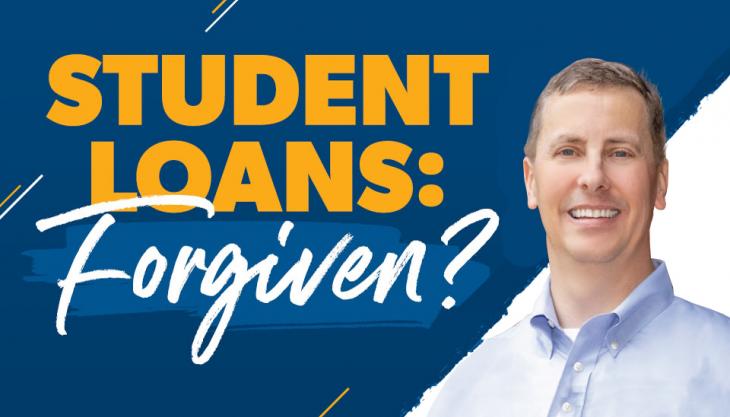Bankruptcy Shift Eases Path for Student Loan Discharges
Submitted by Law Offices of ... on Wed, 12/14/2022 - 12:47pm

The Biden administration has created new measures for facilitating destitute borrowers' ability to discharge crippling federal student loan debt in bankruptcy, generating cautious optimism that much needed financial relief is now more accessible.
The departments of Justice and Education on Nov. 17 announced a new process for bankrupt individuals to discharge student loan debt, wherein the agencies will be newly positioned to help underwater borrowers obtain relief. The government said the move will cut down on "unnecessarily burdensome and time-consuming investigations."
The move represents the most substantial shift by the federal government on the discharge issue in decades. It comes as legal challenges have stalled the White House's plan to forgive an estimated $430 billion in outstanding federal student loan debt.
The new policy offers a "realistic" opportunity for people to discharge their loans in bankruptcy "for the first time," said Edward Boltz, a consumer bankruptcy attorney at the Law Offices of John T. Orcutt.
With a new process that more clearly outlines discharge considerations and instructs the agencies to play a more constructive role, the change could provide more consistency and ease debtors' burden of demonstrating to a bankruptcy court that their student loans impose an "undue hardship."
The change is well short of consumer advocates' greater hope of addressing the nation's $1.6 trillion federal student loan debt crisis by canceling debt and removing strict discharge standards in the bankruptcy code. But it fulfills efforts initiated during the Trump administration to tackle a particularly confounding issue that made undue hardship standards nearly insurmountable.
Some skepticism remains over how the new policy will be carried out by federal agencies that have traditionally fought student loan bankruptcy discharges. Still, lawyers familiar with the process are excited by the prospect of debtors seeing more meaningful relief.
"It has the potential for being a real game changer in this area," said John Rao, an attorney with the National Consumer Law Center.
Easing the Process
To promote more consistent and positive outcomes for student loan borrowers in bankruptcy, the government has implemented a new step in the discharge request process. Under the policy, debtors seeking to erase federal student loan debt will submit a 15-page attestation form to be processed and analyzed by the DOE and DOJ.
Government attorneys are being instructed to use prescribed standards for each submission to assess the undue hardship factors and make a recommendation to the bankruptcy court for each discharge request. In cases where the attestation may not support a complete discharge, the DOJ "will consider supporting a partial discharge," the department said.
The new process is intended to make it easier for the government to identify cases where discharge is appropriate and ease scrutiny. For instance, the Justice Department said it will not necessarily disqualify relief requests from debtors who missed payments or didn't enroll in income-driven repayment plans.
"This is a big step forward" for both agencies, said Cardozo School of Law professor Pamela Foohey, who focuses much of her work on consumer bankruptcy. "To me it suggests that they're making an honest, good faith, thoughtful effort to make the process easier for debtors."
Undue Hardship
Most US bankruptcy courts now use a test established in 1987 by the US Court of Appeals for the Second Circuit in Brunner v. New York State Higher Education Services Corp. to determine if an individual's student loan debt imposes an "undue hardship"-a phrase left undefined in the bankruptcy code.
Passing the "Brunner test"-and thus being deemed eligible to receive a student loan discharge-requires showing an inability to maintain a minimal standard of living if forced to repay, among other standards that must be met.
The process has earned a reputation as being nearly impossible to successfully complete.
In a headline-grabbing decision from 2020, New York bankruptcy judge Cecelia Morris said the Brunner test has been interpreted too harshly for over three decades-to the point where most people "believe it impossible to discharge student loans."
US Under Secretary of Education James Kvaal even acknowledged as much, saying in a statement last month that the bar "has become very difficult for deserving borrowers to clear."
As it stands, fewer than 0.1% of debtors even try to get a discharge of their student loans, said Rao.
Adjusting to Change
Consumer bankruptcy lawyers see the government's willingness to address much maligned caselaw and inconsistent legal applications as an encouraging shift. But hurdles for bankrupt student loan borrowers seeking relief still exist.
Debtors still need to file a lawsuit within a bankruptcy case-what's known as an adversary proceeding-to initiate the request, as well as the attestation form.
"It's not something that people are going to be able to navigate effectively on their own," Boltz said. "They're going to need a lawyer."
It remains to be seen how each discharge request is handled and analyzed, but it seems clear that the DOE and DOJ's goal "is to keep it as consistent as possible," Boltz said.
Much hinges on how bankruptcy judges respond to the form, said Foohey. "Having the DOJ say 'yes' only goes a sliver of the way."
Bankruptcy judges have traditionally had their hands tied by rigid appellate court precedent in their application of the Brunner test. The new process could free judges from applying more draconian standards established by the circuit courts, especially if the DOJ is supporting a debtor's request.
"There's a variation as to how judges approach these things," said Cullen and Dykman LLP attorney Michael Traison. "I think this will help lean them towards leniency."
Imperfect Solution
With the new changes in place, there's not much else the Biden administration can do to help ease the discharge process for the fraction of federal student loan borrowers who end up in bankruptcy.
Many of the approximately 45 million federal student loan borrowers in the US are still waiting to see whether the president's debt cancellation executive order stands up to Supreme Court scrutiny later next year.
In the meantime, consumer bankruptcy advocates hope to see Congress move on a bipartisan bill introduced last year by Sens. Dick Durbin (D-Ill.) and John Cornyn (R-Texas) called the FRESH START Through Bankruptcy Act (S. 2598). The proposal would provide more focused relief by allowing borrowers to discharge student loan debt in bankruptcy without showing undue hardship after a 10-year waiting period.
And while the updated discharge process is expected to simplify things for insolvent borrowers, having a legislative approach that doesn't include undue hardship "is still the preferable way to go," said Rao.
Debts Hurt! Got debt? Need help? Get started below!
Serving All of North Carolina
- Bankruptcy Attorneys Raleigh NC (North)
- Bankruptcy Attorney Fayetteville NC
- Bankruptcy Attorney Durham NC
- Bankruptcy Attorneys Wilson NC
- Bankruptcy Attorneys Greensboro NC
- Bankruptcy Attorneys Southport NC
- Bankruptcy Attorneys Wilmington NC
Bankruptcy Attorneys Raleigh NC (North)
6616 Six Forks Rd #203 Raleigh, NC 27615 North Carolina
Tel: (919) 847-9750

Bankruptcy Attorney Fayetteville NC
2711 Breezewood Ave Fayetteville, NC 28303 North Carolina
Tel: (910) 323-2972

Bankruptcy Attorney Durham NC
1738 Hillandale Rd Suite D Durham, NC 27705 North Carolina
Tel: (919) 286-1695


Bankruptcy Attorneys Greensboro NC
2100 W Cornwallis Dr. STE O Greensboro, NC 27408 North Carolina
Tel: (336) 542-5993

Bankruptcy Attorneys Southport NC
116 N Howe St. Suite A Southport, NC 28461 North Carolina
Tel: (910) 218-8682

Bankruptcy Attorneys Wilmington NC
116 N. Howe Street, Suite A Southport, NC 28461 North Carolina
Tel: (910) 447-2987
